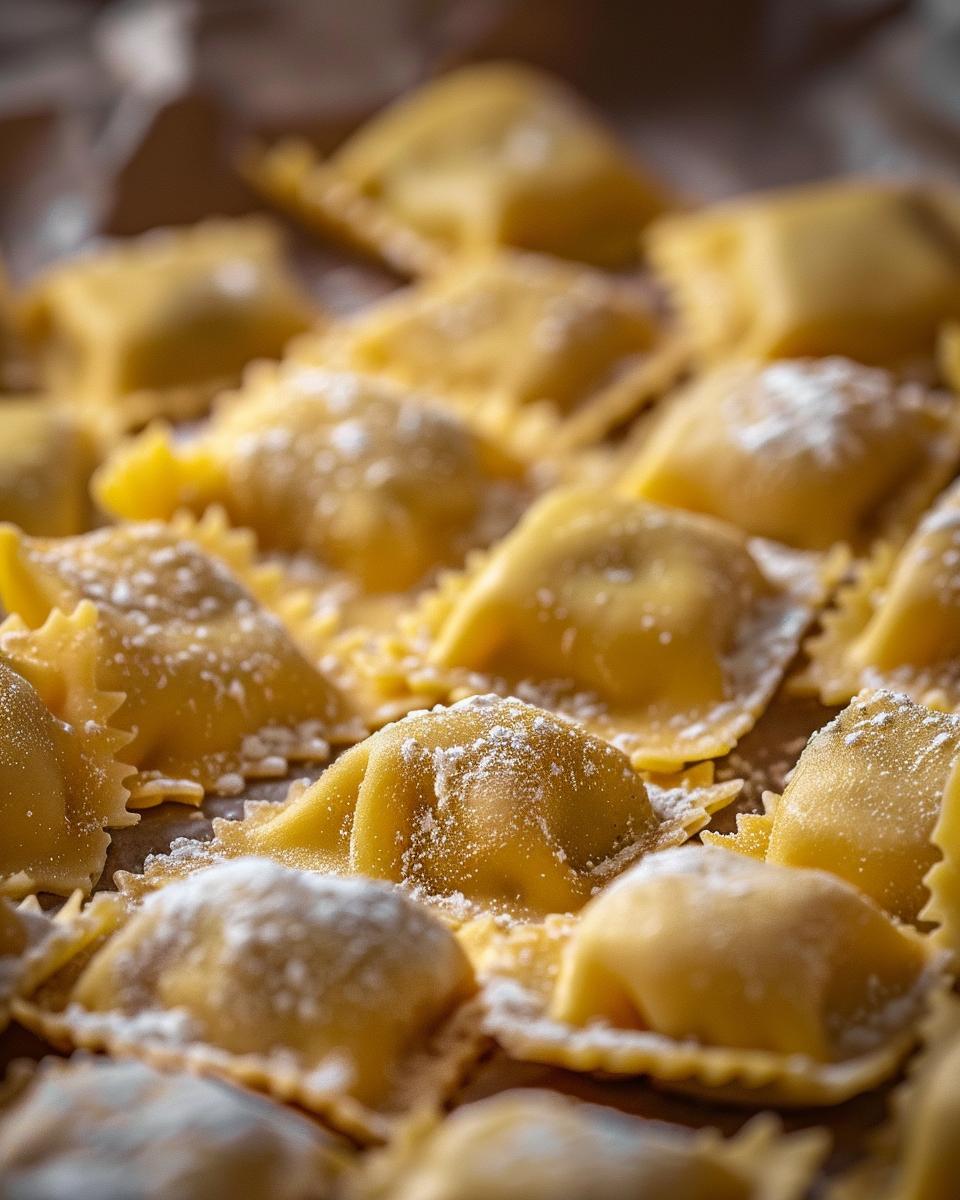Ravioli Dough Recipe: Unlock the Secret to Perfect Homemade Pasta
Are you ready to master the art of making homemade ravioli? This ravioli dough recipe will help you unlock the secret to perfect pasta every time. Whether you’re a novice or a seasoned cook, this guide will take you through each step to create delicious, tender ravioli that will impress your family and friends. Let’s dive into the world of pasta making and elevate your culinary skills!
In this recipe:
- Essential ingredients for ravioli dough
- Step-by-step instructions
- Tips and variations for perfect results
First, gather your ingredients. Flour, eggs, salt, and olive oil form the base of your dough. You may also want to explore additional flavors and variations. Next, follow our detailed steps to mix, knead, and roll out the dough. If you love pasta, you might also enjoy our Easy Baked Ziti Recipe. It’s a fantastic complement to homemade ravioli.
Once your dough is ready, it’s time to shape and fill your ravioli. Experiment with different fillings and shapes to create a unique dish. Cooking the ravioli is simple. Boil them until they float, then pair them with your favorite sauce. For a rich and hearty option, try our Sunday Gravy Recipe. This will transform your pasta night into an unforgettable feast.
By following this ravioli dough recipe, you’ll create pasta that rivals any Italian restaurant. Ready to get started? Let’s make some delicious ravioli!

Who Can Make This Recipe and What You Need
This easy ravioli dough recipe is perfect for anyone, regardless of their cooking experience. Whether you’re a beginner eager to try your hand at homemade pasta or a seasoned home cook looking to perfect your technique, this recipe is for you. While the process is straightforward, it does require some intermediate skills like basic kneading and rolling. Don’t worry; with a bit of practice, you’ll master the art of making ravioli dough by hand in no time.
Essential Tools You’ll Need
- Mixing Bowl: A large bowl to mix your dough ingredients.
- Rolling Pin or Pasta Machine: To roll out the dough to the perfect thickness.
- Knife or Ravioli Cutter: For cutting your dough into ravioli shapes.
Having the right tools will make the process smoother and more enjoyable. If you don’t already own a pasta machine, a rolling pin will do the trick. A ravioli cutter, while not essential, helps create those beautiful, uniform edges. For a comprehensive guide on making fresh homemade ravioli, check out The Clever Carrot’s Beginners Guide to Fresh Homemade Ravioli.
While this recipe is intermediate in difficulty, it’s absolutely achievable with a little patience and practice. You’ll find that the satisfaction of creating your own ravioli from scratch is well worth the effort. Now, gather your tools and ingredients, and let’s make some delicious ravioli!
The Ingredients Needed to Make Ravioli Dough
Now that we’ve covered the minimal equipment needed, let’s talk about the ingredients. The success of your ravioli dough recipe from scratch hinges on selecting the right components. With just a handful of ingredients, you can create the best ravioli dough that will impress everyone at the table.
Gather Your Ingredients
First, let’s start with the essentials. You’ll be surprised at how easy it is to make this egg pasta dough for ravioli with items you likely already have in your pantry.
- 2 cups all-purpose flour – This is the backbone of your dough. It provides the structure needed to hold your ravioli together.
- 2 eggs – These add richness and help bind the dough, giving it that perfect texture.
- 1 teaspoon salt – A little salt goes a long way in enhancing the flavor of your dough.
Choosing the right flour is essential. Some prefer using ravioli dough with semolina for added texture and strength. However, all-purpose flour works perfectly well and is more readily available.
Have you gathered all your ingredients? Great! You’re now ready to move on to the next step. Making the dough is straightforward and fun, so let’s get started!

Step-by-Step Guide on How to Make Ravioli Dough
Now that we’ve gathered all the ingredients, it’s time to dive into the fun part: making the ravioli dough. This step-by-step guide will walk you through the process of creating traditional ravioli dough. Ready to start? Let’s get rolling!
- Combine the Ingredients: In a large mixing bowl, combine 2 cups of flour, 2 eggs, 1 teaspoon of salt, and 1 tablespoon of olive oil. Mix everything together until you form a shaggy dough. This might look a bit messy, but don’t worry—it’s supposed to!
- Add Water Gradually: Next, gradually add water to the dough, one tablespoon at a time. Continue mixing until the dough comes together into a cohesive ball. Be careful not to add too much water; you want the dough to be firm but not sticky.
- Knead the Dough: Turn the dough out onto a floured surface. Now comes the fun part: kneading! Knead the dough for 5-10 minutes until it becomes smooth and elastic. This step is crucial for developing the gluten, which gives the dough its structure and chewiness.
Resting the Dough
After kneading, wrap the dough in plastic wrap and let it rest for at least 30 minutes. This resting period allows the gluten to relax, making rolling the ravioli dough by hand much easier. Trust us; this step will make your life so much simpler when it comes time to shape your ravioli.
- Divide and Roll Out: Once the dough has rested, divide it into four equal pieces. Working with one piece at a time, roll it out to about 1/16 inch thickness. You can use a pasta machine or a rolling pin. If you’re rolling ravioli dough by hand, ensure your surface is well-floured to prevent sticking.
- Cut and Fill: Cut the rolled-out dough into squares or circles, depending on your desired ravioli shape. Place a spoonful of filling in the center of each piece, fold the dough over the filling, and press the edges to seal.
And there you have it! You’ve successfully made traditional ravioli dough. Whether you use a pasta machine or prefer rolling ravioli dough by hand, these steps will help you create delicious, homemade ravioli. Stay tuned for the next section, where we’ll explore various filling options to suit your taste.
Serving and Storing Ideas and Tips
Now that you’ve mastered the art of making ravioli dough, let’s dive into serving and storing your delicious creation. Whether you’re a novice cook or an experienced chef, these tips will help you make the most of your fresh ravioli.
Serving Your Homemade Ravioli
Once your ravioli is cooked, the possibilities for serving them are endless. One classic choice is an easy tomato sauce for ravioli. Simply sauté garlic in olive oil, add crushed tomatoes, and let it simmer until thickened. Season with salt, pepper, and fresh basil for a delightful homemade ravioli sauce recipe. Alternatively, you can try a brown butter and sage sauce for a richer flavor profile.
Don’t be afraid to experiment with other sauces! Pesto, Alfredo, or a simple olive oil and Parmesan cheese combination can also make your ravioli shine. Pair your dish with a fresh salad and a glass of wine to elevate your meal to a restaurant-quality experience.
Storing Fresh Ravioli Dough
If you’ve made extra dough, don’t worry! Fresh ravioli dough storage is straightforward. Wrap the dough in plastic wrap and place it in an airtight container. Store it in the refrigerator for up to two days. When you’re ready to use it, let it come to room temperature before rolling it out.
For longer storage, consider freezing the dough. Roll it into a ball, wrap it tightly in plastic wrap, and place it in a freezer bag. It can be stored in the freezer for up to three months. When you’re ready to use it, let it thaw in the refrigerator overnight.
Now that you know the ins and outs of serving and storing your homemade ravioli, you’re well on your way to impressing your family and friends with your culinary skills. Enjoy your delicious, homemade ravioli with confidence!

Pro Chef Tips for Perfect Ravioli Dough
- Always use high-quality flour for the best texture.
- If the dough feels sticky, add a touch of flour.
- For a tender texture, mix in “00” flour with all-purpose flour.
- Let the dough rest for at least 30 minutes before rolling.
- Roll the dough to 1/16 inch for the ideal thickness.
- Add a bit of white wine for extra flavor and tenderness.
- Dust surfaces and tools with flour to prevent sticking.
- Ensure edges are tightly sealed to avoid filling leakage.
- For a vegan option, replace eggs with water.
- After making ravioli, freeze any extra for future use.
- Always cook ravioli in boiling salted water.
- Experiment with different fillings to find your favorite.
FAQ: Ingredient Replacement Options and Money-Saving Tips
We understand that you might have specific dietary needs or are looking for ways to save money while making delicious ravioli. Here, we answer some of the most common questions about ingredient replacements and budget-friendly tips.
1. Can I make a gluten-free ravioli dough recipe?
Absolutely! To make a gluten-free ravioli dough recipe, you can replace all-purpose flour with a gluten-free flour blend. Look for a blend that contains xanthan gum, as it helps to mimic the elasticity of gluten. You can also use a combination of rice flour, tapioca starch, and potato starch for a similar effect.
2. How do I make a vegan ravioli dough recipe?
To make a vegan ravioli dough recipe, replace the eggs with water. Use about 3/4 cup of water for every 2 cups of flour. You can also add a tablespoon of olive oil for added richness. The dough might be less elastic, but it will still hold up well when rolled out and filled.
3. What are the recommended flours for ravioli dough?
If you’re looking for a more delicate texture, consider using ’00’ flour instead of all-purpose flour. ’00’ flour is finely ground and has a lower protein content, making it perfect for a tender and smooth dough. You can find ’00’ flour at specialty grocery stores or online.
4. Can I freeze ravioli dough to save money?
Yes, making large batches of ravioli dough and freezing portions for later use is a great money-saving tip. After preparing the dough, divide it into portions, wrap them tightly in plastic wrap, and place them in a freezer-safe bag. When you’re ready to use the dough, let it thaw in the refrigerator overnight.
5. What should I do if my dough is too sticky or too dry?
If your dough is too sticky, gradually add more flour until it reaches the desired consistency. If it’s too dry, add a little water, one teaspoon at a time, until the dough comes together. Remember, the dough should be smooth and elastic but not sticky.
For more detailed guidance on making homemade ravioli, check out this helpful guide.












